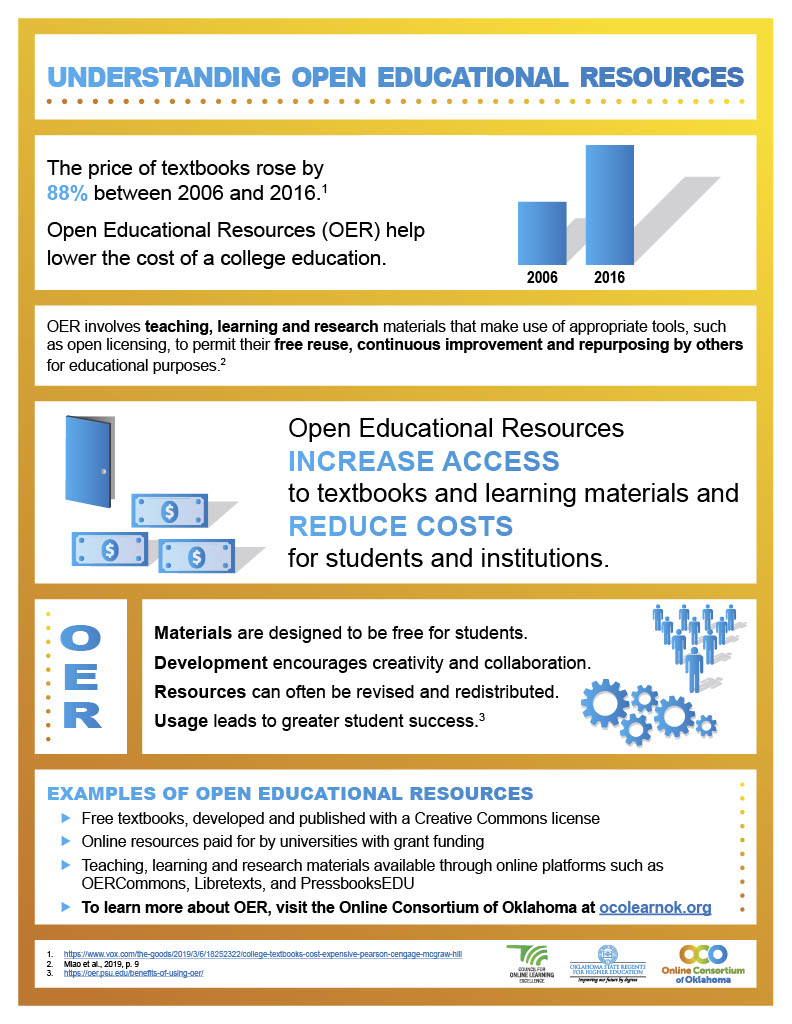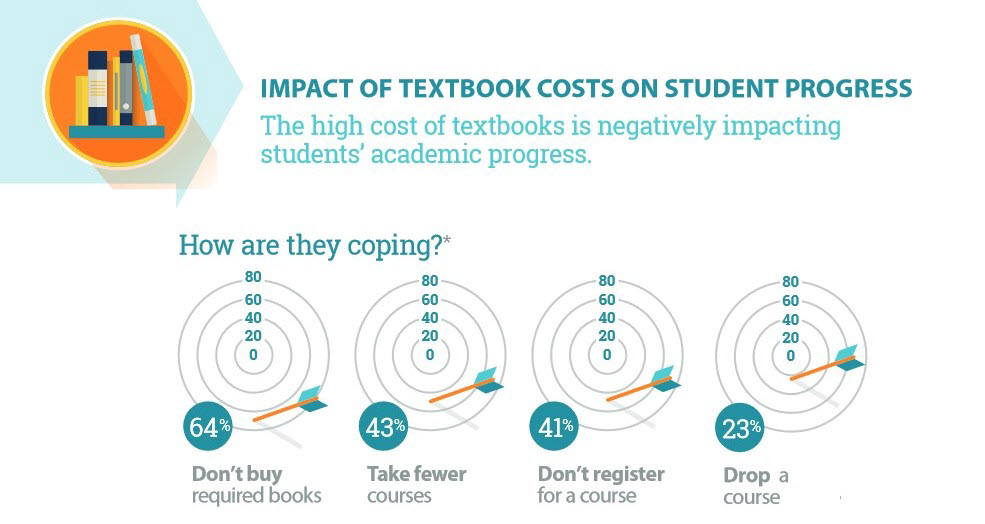2 Why OER?
Learning Objectives
This chapter will support learners in being able to:
- Articulate motivations for OER adoptions and use
- Describe the benefits of OER for students
- Describe the benefits of OER for faculty
- Explore further benefits OER supports, such as equity and inclusion
Understanding the why behind adopting OER
Before we discuss the benefits of OER in detail, please take a few minutes to watch this video from Abbey Elder, Open Access & Scholarly Communications Librarian at Iowa State University. The video reviews the definition of OER but also provides a broad overview of why OER is an effective solution in addressing student barriers to high-quality learning materials. The video also provides examples of how faculty can use OER to enhance their teaching and improve student learning.
You’ll notice that this chapter contains many external links to additional readings on the impact and benefits of OER. Take the time to read these resources to explore further the concepts and points presented in this chapter.
Why use OER?

OER supports a future where students and instructors have free access to a wide variety of high-quality educational resources that have been collaboratively developed, reviewed, revised, and shared across institutions. OER supports a future where educational resources can be easily adapted to fit within the context of specific courses, and to meet the needs of specific students. It also supports a future where the cost of creation, use, and maintenance is much lower than the current rising costs of textbooks and other classroom resources.
SPARC summarizes the why behind using OER with these four points:
- Textbook costs should not be a barrier to education
- Students learn more when they have access to quality materials
- Technology holds boundless potential to improve teaching and learning
- Better education means a better future
Benefits for Students
Using OER can both provide tremendous cost savings for students and impact student success and completion rates. The cost of textbooks can be a huge financial burden on students, which not only affects student success, but could also delay graduation for students who are taking fewer classes per term because of that cost, further increasing financial costs for students over time. OER provide students with day-one access to free course materials, and research reviewed by the Open Education Group shows that most students perform as well or better using OER course materials compared with students using traditional textbooks.
The Florida Virtual Campus’ 2016 and 2018 Student Textbook and Course Materials Survey demonstrates that the cost of commercial textbooks continues to negatively impact student access, success, and completion.

“Infographic: Impact of Student Textbook Costs on Student Progress” by Florida Virtual Campus Office of Distance Learning & Student Services, 2018 is licensed under CC BY 4.0
Student engagement and advocacy are another key benefit to OER. Including your students’ voices in the conversation surrounding affordability and inclusive course materials is critical. Consider reaching out to your Student Government Association and other student groups to get them involved. National groups like Student PIRG have an active campaign on textbook affordability with resources and strategies for students to use. Faculty and administrators can also invite students to serve on planning committees related to OER and textbook affordability. Other ideas for student engagement and advocacy can be found in these resources:
- CCCOER Student Planning
- BCCampus OER Student Toolkit – an advocacy guide for student leaders
Benefits for Faculty
Imagine being able to edit, modify, update, and improve your course materials so the learning outcomes are met and the course material’s content is “exactly the way you want it.” OER allows for this!
The faculty member in this video shares his experience with learning material he’s curated over the years and why he chose to adopt OER. Can you relate?
Open Educational Resources at Santa Fe College {view snippet 0:00 – 1:40}
Faculty using OER enjoy great freedom in selecting course materials that they customize to fit the specific needs of their students and the goals of their classes. Since most OER permit adaptation, educators are free to edit, reorder, delete from, or remix OER materials. OER provide clearly defined rights to users, so educators are not faced with interpreting Fair Use and TEACH Act guidelines.
Open educational resources also provide increased opportunities for faculty to engage in open pedagogical practices with their students. As mentioned above, students play a vital role in OER. Student involvement also provides valuable opportunities for them to help create effective and successful open education programs at your institution. Open pedagogy focuses on instructional approaches which allow students to use, reuse, revise, remix, and redistribute open content. In other words, students move from knowledge consumers to knowledge creators. The ability for students to engage more actively with the OER is a key pedagogical benefit for faculty and students – one that commercially published copyrighted course materials do not provide. To explore the power of open pedagogy further, take a look at the recent publication Open Pedagogy Approaches: Faculty, Library, and Student Collaborations. This comprehensive collection is full of practical tips, ideas, and inspiring stories for faculty.
Other key benefits to faculty include:
Use, Improve, and Share
- Save time and energy by adapting or revising resources that have already been created
- Tailor resources to fit specific context within your courses and research
- Expand interdisciplinary teaching by integrating resources from multiple disciplines
Network and Collaborate with Peers (professional development considerations)
- Access educational resources that have been peer-reviewed by other experts in your field
- Explore reviews and annotations that provide more in-depth knowledge of the resource
- Collaborate on creating new resources that can be used within or across disciplines
Lower Costs and Improve Access to Information
- Reduce the cost of course materials
- Enable all students to have equal access to course materials
- Provide students with the opportunity to explore course content fully before enrolling
Benefits to Institutions
The decision to use OER can occur via a single departmental adoption or it can happen on a college or university-wide scale. Both of these examples require support and investment at an institutional level. This commitment has benefits to institutions as well. For example, OER can increase student retention, progress, and completion by decreasing student costs. Additionally, a recent report from Achieving the Dream, OER at Scale: The Academic and Economic Outcomes of Achieving the Dream’s OER Degree Initiative, reveals that when institutions strategically support and provide OER courses for students there is opportunity for financial return on investment for the institution. Students who enrolled in OER courses tended to enroll in more course credits than students who enrolled in non-OER courses, thus generating additional tuition revenue.
OER: Equity & Openness
When discussing open educational resources and exploring their use and benefits, remember that access and equity are not the same.
This video, Equity in Open Education, explores how equity intersects with open education.
The video above references challenges to OER, such as inequitable access to technology and resources among students and institutions. In addition to this barrier, there are other challenges related to equity in open educational resources. While open educational resources and open practices present opportunities to create and share diverse and inclusive resources, inequities in OER exist. For example, the open community is lacking in diverse voices who author OER. There also are known difficulties finding openly licensed content that is culturally relevant and inclusive. Representation matters and there is work to do in this area!
The Community College Consortium for Open Educational Resources (CCCOER) has collected resources and articles exploring OER through the lens of equity, diversity, and inclusion. These resources are included (and continue to expand) on their Equity & Openness blog.
As you learn more about OER, consider how open education practices and the use of OER can enhance your own teaching practices and learning materials to become more equitable, diverse, and inclusive. As an OER champion, work consciously to resolve the known inequities that exist in open educational resources. Make them truly culturally relevant, inclusive, and representative.
The COVID-19 pandemic offers another example of the benefits of transitioning to openly available course materials. As the impact of the pandemic grew, schools around the world from K-12 to colleges and universities closed their campuses. Institutions rushed to transition to remote learning and services in a matter of weeks. For students who previously relied on college and university libraries for access to physical copies of commercial textbooks (in collections or on course reserve), this access no longer was available. Libraries responded by reaching out to faculty and students to connect them to freely available open educational resources or library-licensed content. A transition to open educational resources and a commitment to making open the default for research and education, provides students with access to online course materials which are always free and affordable.
Concept Review
To complete the Module 2 Final Activity (the next step in earning OCO’s OER 101 badge), return to OER 101 Module 2.
Explore Further
Additional research and videos discussing the impact and benefits of OER for faculty and students are linked below.
Carpenter, F., Davis, W.P. & Sicre, D. (2017, November 15) How OER can Support Student Equity and Diversity. CCCOER Webinar.
Colvard, N., Watson, C. & Park, H. (2018) The Impact of Open Educational Resources on Student Success Metrics. International Journal of Teaching and Learning in Higher Education, 30 (2), 262-276.
Grimaldi, P., Basu Mallick D., Waters A., Baraniuk, R. (2019, March 6) Do open educational resources improve student learning? Implications of the access hypothesis. PLOS|One.
Hilton, J. (2016) Open educational resources and college textbook choices: a review of research on efficacy and perceptions. Education Tech Research and Development, 64(4), 573 – 590.
This video synthesizes the research results discussed in John Hilton’s article above, A Review of the Effectiveness & Perceptions of Open Educational Resources As Compared to Textbooks
Reynado, Kharl. (2018, October 11) OER Diversity Discourse: Bring in the Student Advocates
OpenStax Blog.
Vézina, B. and Green, C. (2020, March 31) Education in Times of Crisis and Beyond: Maximizing Copyright Flexibilities. Creative Commons Blog.
Attributions
Information for this module was consulted and adapted from:
“An Introduction to Open Educational Resources” by Abbey Elder is licensed under CC BY 4.0
“Leveraging the Benefits of OER” in Welcome to Understanding OER by SUNY OER Services is licensed under CC BY 4.0
“Open Education” by SPARC is licensed under CC BY 4.0
“Why Open Education?” by CCCOER is licensed under CC BY 4.0

